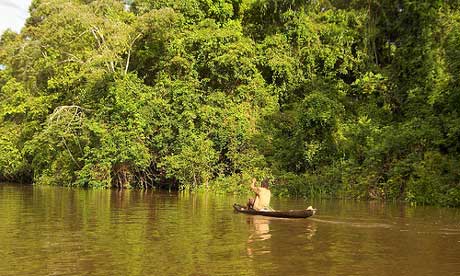
Cross-border connections from neighbouring nations; Colombia in context (unlimited duration, plus Panama, Venezuela, Brazil, Peru and Ecuador)
Travellers criss-crossing Central and South America will find Colombia refreshingly free from mass tourism, full of opportunities to explore the relative unknown and meet famously pro-visitor locals.
Colombia borders Panama, Venezuela, Brazil, Peru and Ecuador but has road connections with Venezuela and Ecuador only. Nightmare stories abound about crossing borders; actually, traffic and pedestrians actually move pretty easily and efficiently between Colombia-Venezuela and Colombia-Ecuador, though both are highly sensitive to political tensions (for the latest news see www.fco.gov.uk/travel).
From Ecuador you’ll need an exit stamp from Ecuadorian customs and an entry stamp from the Colombians (both are free). Ipiales, Colombia’s border town, is well set up for travellers, with dozens of budget hotels and a dirt-cheap, frequent minibus shuttle that connects to the bus station. A good supply of moneychangers also offers deals on dollars and pesos. The town’s airport has links to other Colombian cities, often via Bogotá.
Though technically there are four border crossings between Colombia and Venezuela, the frontier on the main Caracas-Bogotá route (Cúcuta-San Antonio del Táchira) is by far the most accessible. Tensions on the Venezuelan border are particularly prone to flare-ups – check the current situation before heading off. However, even during the frostiest political stand-offs long lines of vehicles and pedestrians cross every day. Visitors should allow plenty of time for this crossing as it is a prime route for contraband, drugs, criminal gangs and oil smuggling – checks can be officious and long-winded, and this isn’t a nice place to hang around any longer than you need. Minibuses (each side) connect to bus stations, airports and hotels.
Travellers heading from Venezuela to Colombia’s Caribbean coast should cross at Paraguachón, on the Maracaibo (Venezuela) to Maicao (Colombia) road.
Panama and Colombia are bridged by the Darién Gap, a remote, jungly, hard-to-access area; the security situation makes a border crossing here unwise. However, cargo boats do sail between Puerto Obaldia (Panama) and Colombia’s seaside resort town of Capurganá. Sea conditions can be rough – wrap luggage in plastic and check boats for life vests. Expect to pay US$10 per person for the hour-long crossing.
Leticia, in the Amazon region, is the only viable border crossing from Peru and Brazil, reached from Iquitos (Peru) and Manaus (Brazil). These trips are well-organised, well publicised and run with regularity. Rates and speeds vary so shop around; allow three to six days for the trip. Pack plenty of mosquito repellent, food, bedding and water.
Few places are as untamed as the Colombian Amazon, which covers almost one-third of the country. Plummeting from the Andes to forested plains, the terrain is characterised by extensive lowlands, rapids and waterfalls.
Local tour operators offer itineraries that include parts of the Peruvian and Brazilian territory, capturing the essence of the Amazon’s vast scale. Tours depart from the jungle frontier town of Leticia at the point where Colombia, Brazil and Peru meet. Many travellers opt for a four-day/three-night foray to Lake Yahuarcaca, Isla Santa Rosa (Peru), Tabatinga (Brazil), Isla de los Micos (for the indigenous settlements of Yagua and Ticuna) and Benjamin Constant (Brazil).
A longer exploration over seven days would link Tarapacá, Benjamin Constant and the Zacambú Reserve (for an overnight safari and kayaking, birding and hiking) before heading to Puerto Nariño (to spot boto – pink river dolphins) and Amacayacu National Park for trekking. This spectacular park is 75km upriver from Leticia; trees can reach up to 50m high, while boglands and rivers are home to caiman, anaconda, piranha and numerous bird species.
Choose a guide who knows the twists and turns of each country’s bureaucratic system – moving around the tri-border region is often as tricky to navigate as the river itself.
Interested in knowing more about Colombia? Then check out these great articles:
Get the low-down on Colombia with our Travel Blueprint and Destination Guide
Mix urban sights with golden lakes and coffee plantations – Bogotá and around (two days - two weeks)
Meet ancient civilisations – The south of Colombia itinerary (two weeks)
From Caribbean charm to the Lost City – Cartegena and the north (two weeks)